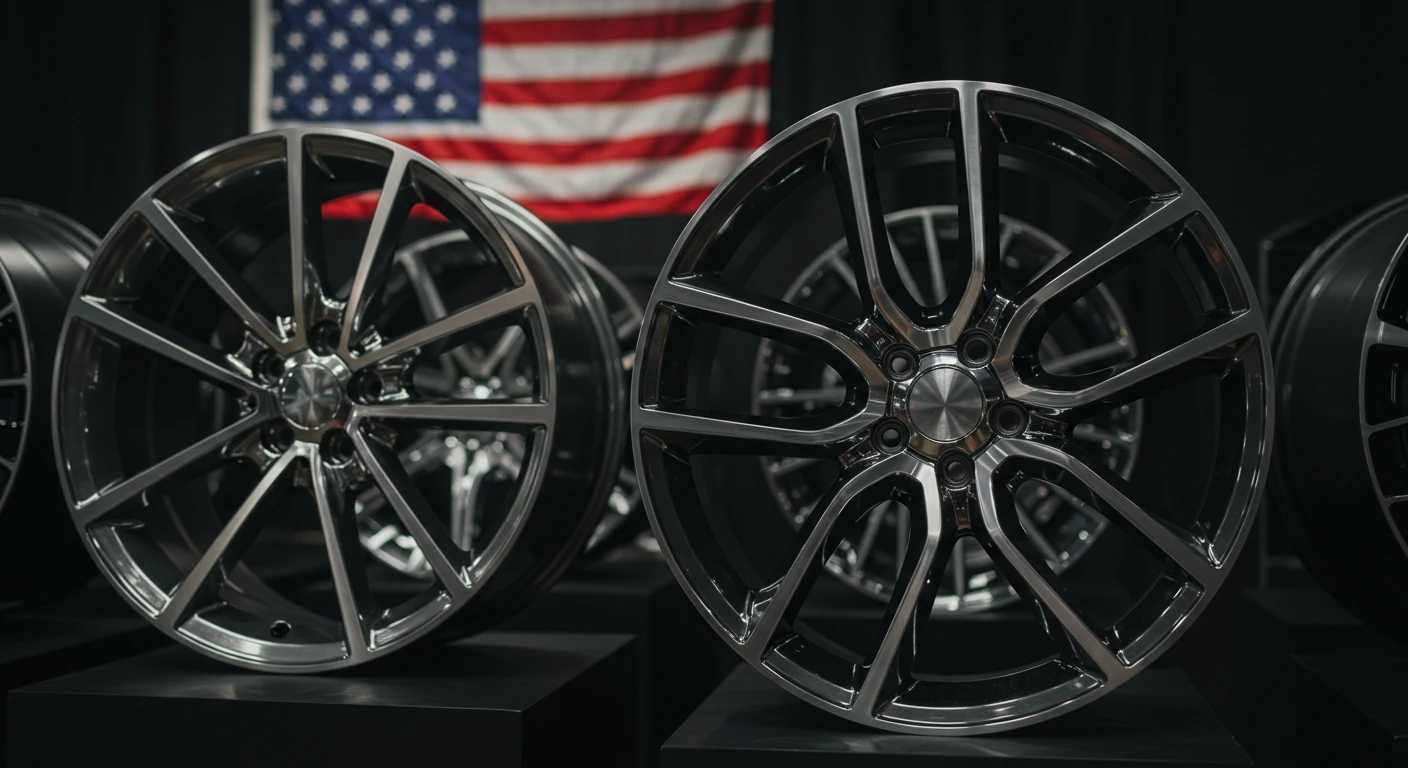How to Buy Wheels in the USA: Guide to Choosing & Sizing 2025

Most people walk into a wheel shop and get completely overwhelmed. The salesperson throws around terms like “offset” and “bolt pattern” while you’re just trying to make your car look better. Here’s what I’ve learned after helping hundreds of drivers find their perfect wheels: the process doesn’t have to be confusing if you know what really matters.
Your car came with wheels that work, but they probably don’t work well. The right aftermarket wheels can transform how your car looks, handles, and even how much it’s worth. But get it wrong, and you’ll be dealing with vibrations, clearance issues, or worse – wheels that don’t fit at all.
Let me walk you through what actually matters when buying wheels, plus the mistakes that’ll cost you money and headaches.
The Truth About Wheel Materials (And What Actually Matters)
Forget everything you’ve heard about wheel materials being complicated. There are really only three options worth considering, and each has a clear use case.
Steel wheels: the cheapest option, but they’re heavy as bricks. Your factory wheels are probably steel if your car came with plastic hubcaps. They’re tough and won’t crack if you hit a pothole, but they’ll kill your acceleration and fuel economy. Only consider steel if budget is your absolute priority.
Aluminum alloy wheels: are where most people should land. They’re lighter than steel, they look way better, and they don’t cost a fortune. Brands like Enkei and American Racing make solid alloy wheels that’ll serve you well for years. The weight savings actually improve your car’s performance – better acceleration, braking, and handling.
Forged aluminum wheels: are the premium option. Companies like HRE and Forgeline make wheels that are stronger and lighter than anything else, but you’ll pay $500+ per wheel. Unless you’re building a serious performance car or money isn’t a concern, forged wheels are overkill for most people.
Here’s what the wheel shops won’t tell you: the difference between a $200 alloy wheel and a $400 alloy wheel often comes down to brand name and finish, not actual performance.
Getting the Size Right (Without the Guesswork)
This is where most people mess up, and it’s not their fault. The wheel industry makes sizing more complicated than it needs to be.
Your current wheel size is stamped right on the tire sidewall. Look for numbers like “225/60R16” – that last number (16) is your wheel diameter in inches. The first number (225) is your tire width in millimeters. You need both pieces of information to make smart decisions.
Going bigger isn’t always better. Sure, 20″ wheels look more aggressive than 16″ wheels, but you’re trading comfort for style. Bigger wheels mean thinner tires, which means you’ll feel every crack in the road. Plus, those low-profile tires cost way more to replace.
Most people should stick within one size of their factory diameter. Going from 16″ to 17″ wheels? That’s usually fine. Jumping from 16″ to 20″? You’re asking for trouble unless you know exactly what you’re doing.
The measurements that actually matter:
- Diameter: How big the wheel is (15″, 16″, 17″, etc.)
- Width: How wide the wheel is (affects tire choice)
- Bolt pattern: Must match your car exactly, or the wheels won’t bolt on
- Offset: Affects how the wheel sits in your fender well
Don’t guess on these numbers. Check your owner’s manual or use online fitment tools to get it right the first time.
Where Smart Buyers Actually Shop for Wheels
The wheel buying landscape has changed completely in the last decade. You’ve got more options than ever, but some are clearly better than others.
Online vs. Local: The Real Comparison
Online retailers offer massive selections, competitive prices, and accurate fitment tools. Companies like Discounted Wheel Warehouse have built their reputation on extensive inventory and reliable fitment guidance. You can read real customer reviews and compare dozens of options without any sales pressure.
The downside? You can’t see or touch the wheels before buying. And if something goes wrong with fitment, you’re dealing with return shipping and delays.
Local wheel shops give you hands-on service, but their inventory is limited and prices are often higher. The value comes from their expertise – a good local shop can spot fitment issues before you buy and handle installation on the spot.
For most people, I recommend researching online but buying locally if you can find the same wheels at a reasonable price. You’ll pay a bit more, but you’ll get better service and support.
Budget Reality Check: What Wheels Actually Cost
Here’s the pricing breakdown nobody talks about honestly:
Budget steel wheels: $75-150 per wheel (plus mounting/balancing) Quality alloy wheels: $150-400 per wheel Premium forged wheels: $500+ per wheel
But here’s the catch – you’re not just buying wheels. Factor in mounting, balancing, valve stems, and possibly new tires. That $200 wheel can easily become $350+ once you’re done.
If the budget is tight, consider wheel and tire financing options that let you spread the cost over time. Many reputable dealers offer financing with reasonable terms, making quality wheels more accessible.
Real Cost Breakdown Example:
| Component | Budget Build | Quality Build | Premium Build |
| Wheels (set of 4) | $600 | $1,200 | $2,400 |
| Mounting/Balancing | $120 | $120 | $120 |
| Valve Stems | $40 | $40 | $40 |
| New Tires (if needed) | $400 | $600 | $1,000 |
| Total Cost | $1,160 | $1,960 | $3,560 |
What to Look for When Shopping
Compatibility: The Non-Negotiable Basics
Your new wheels must match your car’s specifications exactly. There’s no “close enough” when it comes to bolt pattern, center bore, or load rating. Get these wrong and your wheels either won’t fit or won’t be safe.
Check your owner’s manual for the exact specifications, or use online fitment tools by entering your car’s year, make, and model. Most reputable wheel retailers like Discounted Wheel Warehouse have these tools built into their websites and offer fitment guarantees to ensure you get the right wheels the first time.
Red flags that indicate poor fitment:
- Wheels that require spacers to fit properly
- Significant changes to speedometer readings
- Rubbing against fenders or suspension components
- Vibration at highway speeds
Quality Markers That Actually Matter
Not all wheels are created equal, even at the same price point. Here’s what separates good wheels from junk:
DOT compliance markings are required for street use in the USA. If the wheels don’t have DOT markings, they’re not legal for road use. Don’t take shortcuts here.
Brand reputation matters more than most people realize. Companies like BBS, Enkei, and American Racing have decades of experience and stand behind their products. Unknown brands might save you money upfront, but could cost more in the long run.
Warranty coverage varies wildly between manufacturers. Some offer limited lifetime structural warranties, while others give you just one year of finish protection. A strong warranty suggests the manufacturer believes in their product.
The Smart Way to Buy Wheels
Research Phase: Do Your Homework
Start by identifying what you actually want from new wheels. Better looks? Improved handling? Lighter weight? Your priorities should drive your research, not flashy marketing photos.
Use online tools to narrow down compatible options for your specific vehicle. Read actual customer reviews, not just professional reviews. Real buyers will tell you about long-term durability, finish quality, and fitment issues.
Create a shortlist of 3-5 wheel options that meet your needs and budget. Don’t fall in love with one set – having alternatives gives you negotiating power and backup options.
Making the Purchase
Whether you’re buying online or locally, double-check everything before hitting “buy.” Verify your vehicle information, confirm the exact specifications, and understand the return policy.
For online purchases, many retailers like Discounted Wheel Warehouse offer detailed fitment guarantees and customer support to help you get the right wheels the first time. Their extensive selection and competitive pricing make them a solid choice for most buyers.
Before you finalize any order:
- Confirm wheel size, bolt pattern, and offset
- Verify warranty terms and coverage
- Understand return/exchange policies
- Factor in total costs, including installation
Installation and After-Care
Professional installation isn’t just recommended – it’s required for your safety. Proper wheel installation involves correct torque specifications, balancing, and alignment checks that most people can’t do at home.
A good installer will check for clearance issues, ensure proper wheel-to-hub contact, and verify that everything spins true. They’ll also provide proper torque specifications for future tire rotations.
According to automotive industry expert Sarah Johnson, “The most satisfied customers are those who prioritize fitment and quality over just appearance. When you get the fundamentals right, the style follows naturally.”
Common Mistakes That Cost Money
The “Bigger is Better” Trap
The biggest mistake I see? People are going too big with their wheel diameter. Yes, 22″ wheels look impressive, but they’re often impractical for daily driving. The ride quality suffers, replacement tires cost a fortune, and you’re more likely to damage a wheel on a pothole.
Stick within one or two sizes of your factory diameter unless you have specific performance goals that require larger wheels.
Ignoring Total Cost of Ownership
That $200 wheel might seem like a bargain until you factor in the cheap tires it requires, the poor finish that starts peeling after six months, or the lack of warranty support when something goes wrong.
Quality wheels from reputable manufacturers cost more upfront but often save money over time through better durability and warranty support.
Buying Based on Looks Alone
Your wheels need to match your actual driving needs, not just your style preferences. If you’re daily driving in a city with terrible roads, those ultra-low-profile performance wheels will make your life miserable.
Consider where and how you actually drive before falling in love with a particular style.
What’s Next for Wheel Buying
The wheel industry keeps evolving, with new manufacturing techniques making quality wheels more affordable. Flow-formed wheels offer near-forged strength at alloy prices, and online retailers are improving their fitment tools and customer service.
We’re also seeing more integrated technology, like tire pressure monitoring system compatibility and better corrosion resistance for harsh climates.
The key is staying focused on what actually improves your driving experience rather than chasing trends that look cool but don’t deliver practical benefits.
Frequently Asked Questions
Should I buy wheels online or from a local shop?
Online offers better selection and prices, but local shops provide hands-on service and immediate installation. Research online, but consider buying locally if prices are reasonable and service is good.
How much bigger can I go with wheel size?
Most vehicles can handle one size increase (16″ to 17″) without major issues. Going more than two sizes bigger often requires additional modifications and compromises ride quality.
Are expensive wheels really worth the extra cost?
Quality wheels from reputable brands offer better durability, warranty support, and resale value. The difference between a $200 wheel and a $400 wheel is often significant in real-world use.
What happens if I buy wheels that don’t fit properly?
Improperly fitted wheels can cause vibrations, premature tire wear, and even safety issues. Always verify fitment before purchasing and use reputable retailers with return policies.












